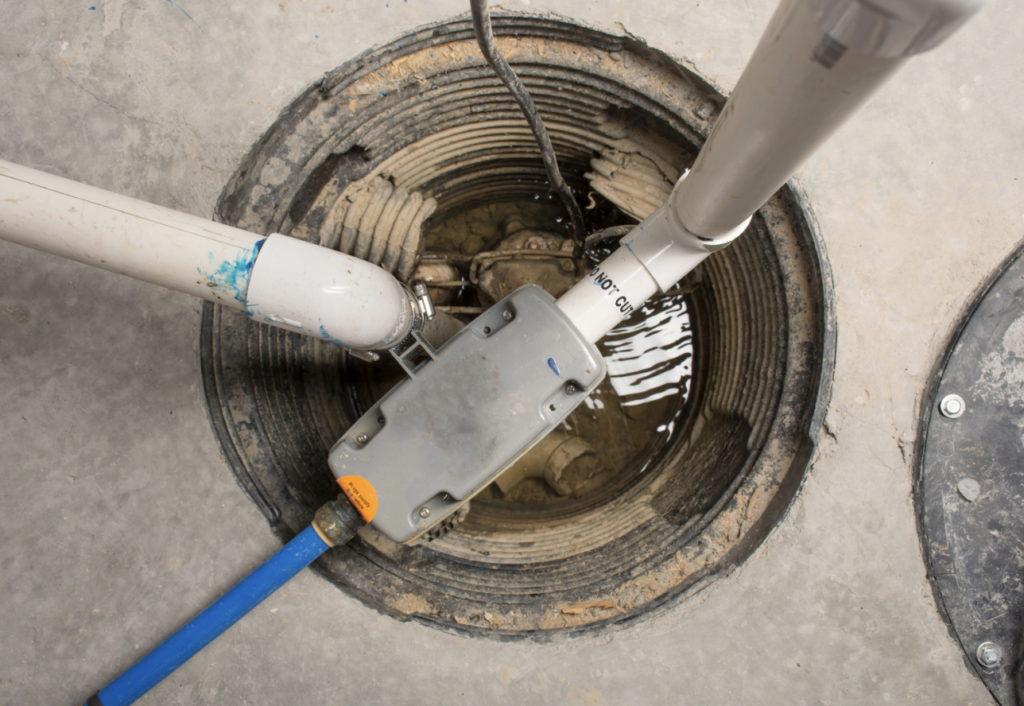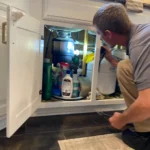For homeowners in areas prone to flooding or those with below-ground basements, managing water intrusion can be essential to protect the home’s foundation and prevent damage. A sump pump is a practical solution for keeping your basement dry and protecting against flooding, but not all homes require one. This guide explores how sump pumps work, the benefits of sump pump installation, and how they contribute to effective basement waterproofing.
What is a Sump Pump?
How Sump Pumps Work
A sump pump is a device designed to remove accumulated water from a sump basin, usually located in the lowest part of a basement or crawlspace. The pump activates when water levels rise to a certain point, channeling excess water away from your home’s foundation through a discharge pipe. This process prevents water from seeping into your basement or damaging your home’s foundation, especially during heavy rainfall or snowmelt.
Types of Sump Pumps
There are two main types of sump pumps, each with unique features suited to different situations:
- Submersible Sump Pump: This type is placed directly within the sump pit and is designed to operate underwater. Submersible pumps are powerful and quiet, making them ideal for homes with frequent flooding concerns.
- Pedestal Sump Pump: Positioned above the sump pit, pedestal pumps have a motor on top and a hose that reaches into the basin. These pumps are generally less expensive and easier to maintain, though they may be louder than submersible models.
The Benefits of Sump Pump Installation
1. Preventing Basement Flooding
One of the primary benefits of sump pump installation is the prevention of basement flooding. When heavy rains or melting snow cause groundwater levels to rise, sump pumps quickly remove water from the area, helping to keep your basement dry and reducing the risk of water damage.
2. Protecting the Home’s Foundation
Water accumulation around your home’s foundation can cause soil to shift, leading to cracks and instability. By redirecting excess water away from the foundation, a sump pump can prevent costly structural damage and protect the integrity of your home.
3. Reducing the Risk of Mold and Mildew
Dampness in basements provides an ideal environment for mold and mildew growth, which can affect indoor air quality and cause respiratory issues. By keeping your basement dry, a sump pump contributes to better air quality and a healthier living environment.
4. Increasing Property Value
For homes in flood-prone areas, a properly installed sump pump and basement waterproofing system can enhance property value. Potential buyers will appreciate the added protection, making your home more appealing on the market and reducing potential inspection concerns.
5. Lowering Insurance Premiums
Many insurance companies offer discounts on premiums for homes equipped with flood prevention measures like sump pumps. By reducing the risk of water damage, sump pump installation can save you money on homeowner’s insurance in the long run.
Signs You May Need a Sump Pump
1. Your Basement Floods Frequently
If you’ve experienced frequent flooding or water pooling in your basement, a sump pump is an effective solution. Even minor water intrusions can lead to mold, mildew, and foundation damage over time. Installing a sump pump is a proactive measure that addresses water intrusion before it becomes a costly problem.
2. You Live in a Low-Lying or Flood-Prone Area
Homes situated in low-lying areas, near rivers, or regions with high water tables are more susceptible to basement flooding. If you live in a flood-prone area, sump pump installation can provide peace of mind and essential protection against water intrusion.
3. You Notice Dampness or Musty Odors in the Basement
Dampness, condensation, and musty smells in the basement are indicators of excess moisture, which can lead to mold growth and air quality issues. Even if you haven’t experienced flooding, a sump pump can help maintain dryness and prevent the buildup of moisture-related issues.
4. You Have a Finished Basement
For homeowners with finished basements, the risk of water damage is particularly concerning. Carpeting, furniture, and electronics are vulnerable to even small amounts of water intrusion. A sump pump is essential to protect your investment in a finished basement by preventing water from accumulating and causing damage.
5. There Are Visible Cracks in the Foundation
Cracks in the basement walls or foundation can be a sign that water is putting pressure on your home’s structure. These cracks allow water to seep into the basement and weaken the foundation over time. Installing a sump pump can alleviate this pressure by redirecting water away from the foundation, preventing further damage.
Sump Pump Installation: What to Expect
Choosing the Right Location
When installing a sump pump, choosing the right location is crucial. The pump should be placed in the lowest point of the basement or crawlspace, where water is likely to accumulate. This location ensures that the pump activates efficiently when water levels rise, maximizing its effectiveness.
Preparing the Sump Pit
The first step in sump pump installation is preparing the sump pit. This involves digging a hole in the basement floor, which serves as a basin for water to collect before it is pumped out. The sump pit must be deep and wide enough to accommodate the pump and provide adequate space for water collection.
Installing the Pump and Discharge Pipe
Once the pit is prepared, the sump pump is installed, followed by the discharge pipe, which directs water away from the home’s foundation. The discharge pipe should be positioned to release water a safe distance from the house, preventing it from re-entering the foundation area.
Testing the System
After installation, testing the sump pump is essential to ensure it functions properly. A professional plumber will fill the pit with water to activate the pump, observing its performance and making any necessary adjustments. Regular testing is also recommended as part of ongoing basement waterproofing maintenance.
Maintenance Tips for Long-Lasting Sump Pump Performance
1. Test the Pump Regularly
Testing the sump pump every few months ensures that it activates properly when water levels rise. Pouring water into the pit allows you to check that the pump starts automatically and efficiently removes water from the basin. Regular testing prevents unpleasant surprises during heavy rains or snowmelt.
2. Clean the Sump Pit and Pump
Over time, debris and sediment can accumulate in the sump pit, potentially clogging the pump or discharge pipe. Cleaning the sump pit and pump at least once a year ensures optimal performance. Remove any debris and flush the system to keep it functioning smoothly.
3. Check the Discharge Pipe for Blockages
The discharge pipe directs water away from your home’s foundation, so it’s essential to keep it clear of blockages. Inspect the pipe regularly for signs of clogs, freezing, or damage. Ensure that the discharge point is free from debris to allow water to flow freely.
4. Invest in a Battery Backup System
A power outage during a heavy rainstorm can render a sump pump useless, which is why a battery backup system is a wise investment. Backup systems activate when power is lost, ensuring that the pump continues to operate even during severe weather.
5. Schedule Annual Professional Inspections
Annual professional inspections help identify wear and tear, ensuring your sump pump remains in top condition. A licensed plumber can check for signs of damage, clean components, and verify that the pump is ready to handle heavy water loads during wet seasons.
The Role of Sump Pumps in Basement Waterproofing
Preventing Water Damage and Structural Issues
A sump pump is a cornerstone of effective basement waterproofing, preventing water from accumulating around the foundation and causing damage. By actively removing water, a sump pump helps maintain the stability of your home’s foundation and reduces the likelihood of costly structural repairs.
Enhancing Indoor Air Quality
Excess moisture in the basement can lead to mold and mildew, which negatively impacts indoor air quality. Sump pumps play a vital role in maintaining a dry, mold-free environment, especially in basements, which are naturally more prone to dampness. A dry basement not only improves air quality but also creates a healthier living space.
Complementing Other Waterproofing Measures
Sump pumps are most effective when used alongside other basement waterproofing measures, such as:
- French Drains: These are trench drains that direct groundwater away from your foundation, reducing water pressure around your home.
- Waterproof Sealants: Applied to basement walls, these sealants prevent moisture from seeping through cracks and pores in the concrete.
- Downspout Extensions: Extending downspouts directs rainwater further away from the foundation, reducing the risk of pooling near the house.
By combining sump pump installation with these waterproofing strategies, you can effectively protect your basement from water damage and enhance your home’s value.
Conclusion: Is a Sump Pump Right for Your Home?
If you live in an area prone to flooding, have a below-ground basement, or are dealing with persistent dampness, sump pump installation is a wise choice. From preventing water damage to improving indoor air quality, sump pumps offer essential protection that can save you from costly repairs and enhance your home’s safety. Paired with other basement waterproofing methods, a sump pump is a valuable investment in both the health of your home and your peace of mind.
Frequently Asked Questions
1. How do I know if I need a sump pump?
Signs that you may need a sump pump include frequent basement flooding, musty odors, visible foundation cracks, or living in a flood-prone area. If your basement is consistently damp, a sump pump can help keep it dry.
2. What’s the difference between submersible and pedestal sump pumps?
Submersible pumps sit inside the sump pit and operate underwater, making them powerful and quiet. Pedestal pumps have a motor above the pit, which makes them easier to maintain but generally louder.
3. How often should I test my sump pump?
Testing every few months is recommended, especially before the rainy season. Regular tests ensure that the pump activates when water levels rise and prevents unexpected flooding.
4. Can a sump pump prevent mold growth?
Yes, by keeping the basement dry, a sump pump reduces the moisture that mold needs to grow. A dry environment helps prevent mold and mildew, improving indoor air quality.
5. Should I install a battery backup for my sump pump?
A battery backup is advisable, especially if your area is prone to power outages. It ensures that your sump pump remains operational during storms when flooding risks are highest.











